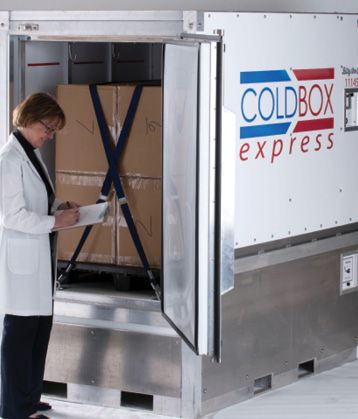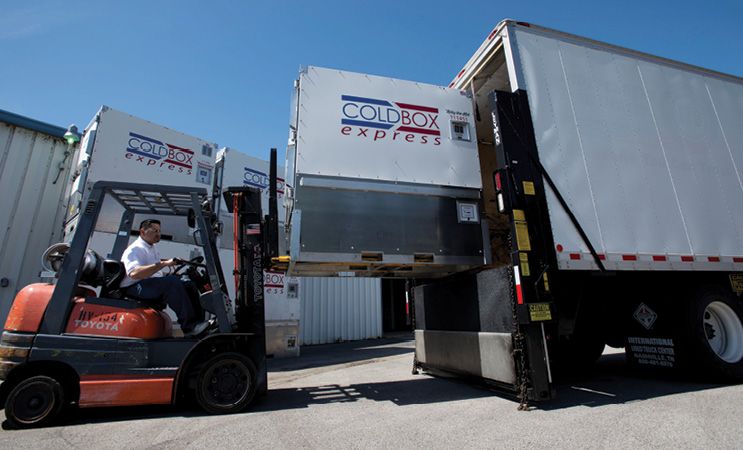Active shipping containers are transforming ground-based cold chain shipping
Pallet-size, powered containers provide more options for less-than-truckload shipping
Cold Box pallet capacity

Meeting the
growing requirements for economical, safe and documented temperature-controlled shipping solutions is among the most difficult challenges facing pharmaceutical suppliers and their 3PLs today. Small, less-than-truckload (LTL) shipments of valuable biomedical materials pose a difficult and specific challenge, as shippers find dedicated refrigerated-truck (“reefer”) options expensive and lacking proper tracking and reporting services. Reefers or related powered refrigeration units are known in the industry as “active” containers; the more typical shipping option is a “passive” container consisting of layers of insulation and a source of cold such as chilled gel packs. Passive solutions for pallet-sized shipments are cumbersome and time-consuming, and often fail to achieve appropriate reliability and reporting goals.
A growing number of shippers are turning to active, self-powered shipping containers that provide intelligent temperature control via compression cooling and forced-air heating. Such active containers are well known in the context of international air freight; these units are required to meet FAA or other standards for onboard equipment. Now, however, active technology is revolutionizing the ground-based shipping industry with integrated remote temperature management according to the shipper’s precise criteria, plus enhanced packaging security and real-time monitoring and reporting. These shippers are especially suitable for high-value cargo, including pharmaceuticals, biologics, and numerous other life sciences and chemical products.
The Drug Supply Chain Security Act, along with FDA 21 CFR GMP and GDP requirements, have turned a spotlight on the value of these intelligent temperature-controlled transportation solutions. 3PLs tasked with executing high-value sensitive shipments are under pressure to find creative and economical solutions that meet these requirements while giving the supplier/shipper greater control and visibility into their supply chain. They must weigh the benefits between traditional passive temperature-controlled shipping and newer active solutions.
Cold Box is targeted for less-than-truckload shipping

Traditional pallet-sized passive shippers present several known challenges, from cumbersome assembly and preparation of the units to the single-use nature of the containers. They require an on-site supply of the appropriate phase-change material (PCM), frozen to specification, plus time-consuming assembly, and the careful loading and management of both the PCMs and the cargo. Passive shippers can pose very real risks to their contents as well, with limited shipment times and little or no recovery in the case of transportation delays or incidents. Furthermore, monitoring is uncertain as the temperature-tracking devices are typically designed for post-trip review only.
Active shipping containers, on the other hand, are “load and go.” They arrive pre-conditioned to the customer’s specifications, so all the customer has to do is open the container, load the cargo and close the door. The units are handled with a forklift or pallet jack, and load directly from the customer’s dock to the LTL truck. Temperature is tracked throughout the trip, with excursion alarms that communicate to the customer in real time. The units are built to withstand the rigors of the trucking network, and may be locked and marked by the customer for additional safety and cargo protection. The technology is green and the containers are built to last at least 10 years.
Economical option
Perhaps the most attractive advantage of active shippers is the cost savings. Because these units feature self-contained temperature control and tracking, they can be transported in mixed or LTL loads with dry freight, saving the customer up to 70% over dedicated reefer trucking. Comparisons to specialized carriers may yield even greater savings.* Active containers, at least in the case of those supplied by Cold Box Express, are available nationwide for one-way rental, which increases the ease of use and the economics of a shipment.
Though designed only for ground transportation at this time, active, temperature-controlled shippers provide vital support for international air shipments as a complementary and economical alternative for US airport ingress and egress. Rather than hiring dedicated refrigerated trucks or extending service for expensive active air cargo containers, these shippers make it possible to transport valuable cargo to and from the customer via dry van or LTL.
Currently, the Huntsville, AL-based company Cold Box Express makes the only active temperature-control pallet shipper designed for the rigors of the mixed load ground transportation market, having essentially invented this space for ground transportation in the US.
In addition to precision temperature control and ease of use, one of the most innovative features of the Cold Box shipper is its specialized tracking device that includes both GPS and cellular connectivity. The company automatically monitors all activity 24/7, but also gives full tracking access to customers who wish to monitor their own shipments. At the end of each transport, the company provides a compliance report complete with a summary of temperature performance and the underlying data in five-minute increments. This level of visibility and control was previously offered only by specialty carriers at a premium price; real-time tracking is now much more economically feasible with Cold Box’s active monitoring capabilities.
While the Cold Box is not designed for air cargo, one of its highest and best uses is in support of its customer’s international freight operations. Several 3PL customers have reduced the ground cost of an international shipment by employing the Cold Box + LTL shipping for the transit of pharmaceutical products to and/or from the airport. In many cases, the airborne active container cannot leave the perimeter of an airport cargo area; some type of transfer to other transportation systems is necessary.
Previously, most of these shipping elements were completed with costly dedicated refrigerated trailers, or by extending the rental of expensive air cargo containers aboard dedicated trailers, even when only one or two pallets of product are carried. Shippers report reduced total costs of transit plus the added benefit of necessary monitoring and reporting to and from the shipping origin or destination.
A more common domestic experience involves a Southern California manufacturer of laboratory reagents that formerly shipped product to its distributors using a cumbersome dry ice bin with varying degrees of success. The Cold Box has replaced this awkward and uncertain shipping practice. The customer now utilizes two Cold Box units for two separate products with two different temperature requirements. The customer reports greatly improved reliability and reduced cost.
The Cold Box option is coming to market at a time when heightened attention to regulatory compliance and cost efficiencies in the supply chain are growing rapidly. It is serving a specific and growing niche. For now, the service is available only in the US and Canada, but the company expects to expand internationally in the future.
*These cost savings are realized alongside enhanced temperature control and real time tracking, monitoring, and reporting.

Foster McDonald is founder and CEO of Cold Box Express, Inc.
Inside the Cold Box
The standard Cold Box unit is a rugged insulated container with a pallet-size payload area. Temperature control is provided by a self-contained refrigeration compression system, combined with a forced-air heater to prevent freezing conditions. Standard temperature range is -20°C to 49°C, with adjustable setpoints controlled precisely to within 1°C. The temperature control equipment is powered by onboard, rechargeable batteries with up to 150+ hours of autonomous operation, depending on ambients and temperature requirements. Supplemental or back-up power can be accomplished with an inverter system in the truck… but part of the value is to be able to transit without this type of assistance. As there is no dry ice or phase-change material, the only emissions from the unit are warm air, making the unit an environmentally benign and safe option. Conveyance by rail is also possible.
Typically, the unit is rented, with options for daily rates, one-way trips, and monthly or longer leases. A network of 20 depots around the US makes the unit generally available for next day delivery to any US location. Units are preconditioned to customer specification prior to delivery for expedited loading and immediate transit.
Save
Save
Save
Save
